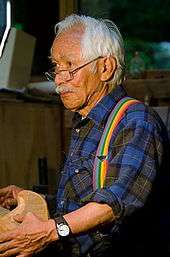Nathan Jackson (artist)

Nathan Jackson (born August 29, 1938[1]) is an Alaska Native artist. He is among the most important living Tlingit artists[2] and the most important Alaskan artists.[3] He is best known for his totem poles, but works in a variety of media.
Jackson belongs to the Sockeye clan on the Raven side of the Chilkoot Tlingit.[1] As a young adult, he served in the military in Germany, and then became involved in commercial fishing.[1] While ill with pneumonia and unable to fish, he began to carve miniature totem poles.[1] His interest in art was piqued, and he enrolled in the Institute of American Indian Arts in Santa Fe, New Mexico.[1] Since then, Jackson's work has included large totem poles, canoes, carved doors, wood panel clan crests, masks, and jewelry.[1] Jackson has worked to pass on traditional Tlingit carving skills to younger artists, and has offered many demonstrations and workshops in Alaska and the Pacific Northwest.[1]
Jackson has created more than 50 totem poles,[4] some of which are on display in the National Museum of the American Indian,[5] the Field Museum in Chicago,[6] Harvard University's Peabody Museum,[7] and other museums in the United States, Europe, and Japan.[1] Other totem poles stand outside Juneau-Douglas High School,[8] Juneau's Centennial Hall,[8][9] in Juneau's Sealaska Building,[8] in Totem Bight State Historical Park,[10] at the Alaska Native Heritage Center,[3] at Saxman Totem Park,[11] and at the Totem Heritage Center in Ketchikan.[9] He is a recipient of a National Endowment for the Arts National Heritage Fellowship (1995),[1] a Rasmuson Foundation Distinguished Artist Award (2009),[12][13] and an honorary doctorate in humanities from the University of Alaska Southeast.[1]
Jackson currently resides in Ketchikan, Alaska.[14] His wife and son are also artists.[6]
References
- 1 2 3 4 5 6 7 8 9 10 "Nathan Jackson". National Endowment for the Arts. Retrieved April 2, 2011.
- ↑ "Contemporary artists: Tlingit". American Museum of Natural History. Retrieved April 2, 2011.
- 1 2 Dunham, Mike (August 31, 2010). "Tlingit 'peace' headpiece now in Juneau museum". Juneau Empire.
- ↑ Rennicke, Jeff (May–June 2008). "Totem poles". Via. AAA Northern California, Nevada and Utah.
- ↑ "Kaats (depicting the story of a man who lived with a bear family)". National Museum of the American Indian. Retrieved April 2, 2011.
- 1 2 "Field Museum's new totem pole erected". MSNBC.com (Associated Press). April 2, 2007.
- ↑ "NAGPRA in the Museum GalleriesNAGPRA in the Museum Galleries". Peabody Museum of Archaeology and Ethnology. Retrieved April 2, 2011.
- 1 2 3 "A list of local totem poles". Juneau Empire. August 26, 2010.
- 1 2 Hilary Stewart (1993). Looking at totem poles. Douglas & McIntyre. p. 183. ISBN 978-1-55054-074-1.
- ↑ "Totem Poles at Totem Bight State Historical Park". Alaska Division of Parks and Outdoor Recreation. Retrieved April 2, 2011.
- ↑ Holing, Dwight (February 22, 1987). "Totems speak of another way". Milwaukee Journal. p. H1.
- ↑ Stalzer, Cassandra (May 15, 2009). "Nathan Jackson receives $25,000 Distinguished Artist Award; Foundation Also Names Eight Fellows, 17 Project Grants". Rasmuson Foundation. Retrieved April 2, 2011.
- ↑ Dunham, Mike (May 16, 2009). "Rasmuson Grants are announced". Anchorage Daily News.
- ↑ "Nathan Jackson receives $25,000 Distinguished Artist Award". Capital City Weekly. May 20, 2009. Retrieved April 3, 2011.